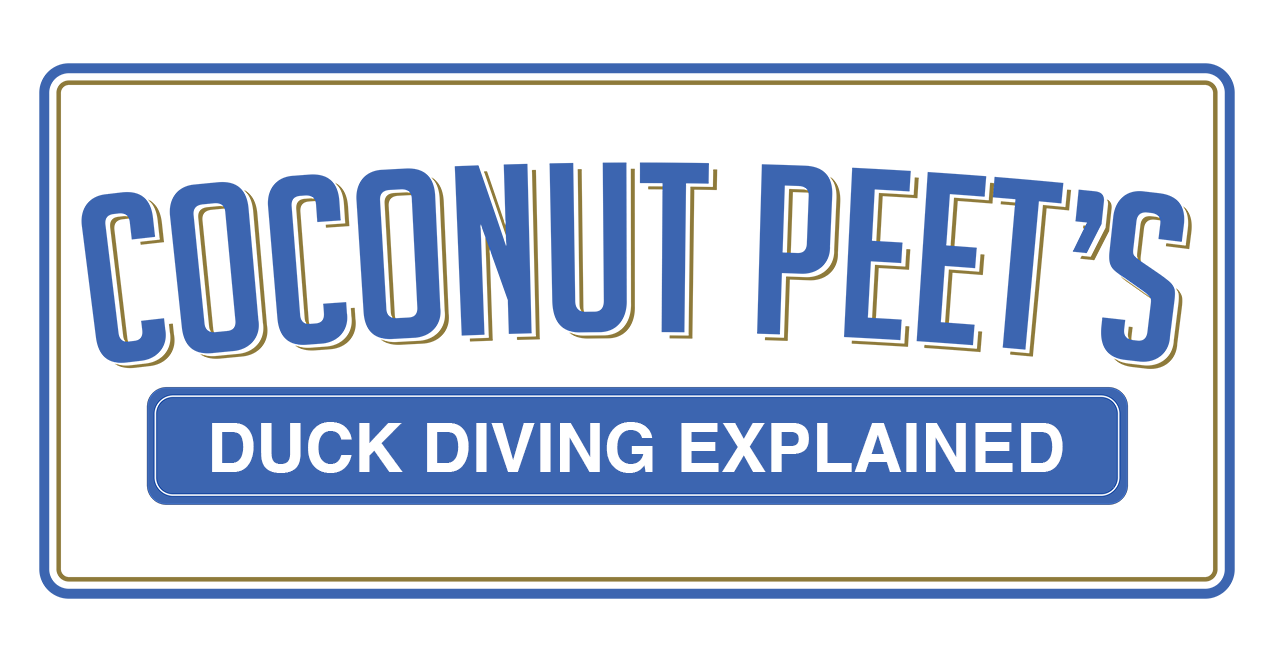Your cart is currently empty!

Master the Surfing Duck Dive & Pass Through More Waves
Duck Diving for Surfing—Explained
Carving through waves is an exhilarating experience, but sometimes you gotta go under to get on top. Mastering the duck dive is an essential surfing skill, allowing you to navigate breaking waves and position yourself for the perfect ride. Here at Coconut Peet’s Surfboard Repair and Trading Company, we want to equip you with the knowledge to conquer any wave with confidence!

What is a Duck Dive?
The duck dive is a maneuver where you push your surfboard underwater to pass beneath an oncoming wave. This technique is crucial for positioning yourself in the lineup and avoiding getting pummeled by whitewater.
Gearing Up:
Before diving in, ensure your surfboard leash is secure and won’t snag during the process. A well-maintained leash prevents losing your board and potential hazards to others.
Duck Dive Essentials:
- Paddle Power: As the wave approaches, paddle vigorously to gain momentum. This forward motion helps push the board under the water.
- Grab & Hold: Locate the rails (grippy sides) of your board about chest-high. Grab them firmly with both hands as the wave gets closer.
- Take a Breath: Inhale a deep, full breath to hold while submerged.
- Dive! Dive! Dive!: With your hands gripping the rails, push down on the board and extend your arms forward. Simultaneously, tuck your head and bend at the waist, pushing your body weight forward.
- Knee Down, Board Down: Use your dominant leg’s knee to drive the nose of the board down and deep underwater. Your other foot should be pushing down on the tail for added leverage.
- Streamline & Glide: Imagine your body and board as one unit. Maintain a streamlined position while submerged, kicking your legs like a frog kick for better control.
- Pop Up & Paddle Out: Once you feel the wave pass overhead, feel for the ocean floor and push up with your arms to resurface. Quickly transition to paddling to escape the whitewater’s pull and regain your position in the lineup.
Practice Makes Perfect:

Mastering the duck dive takes time and practice. Here are some additional tips:
- Start in Calm Waters: If you’re a beginner, practice duck diving in a pool or whitewater to get comfortable with the movement. Practicing to duck dive in smaller waters first will help build your confidence!
- Focus on Breath Control: Holding your breath can be nerve-wracking at first. Practice holding your breath for extended periods while staying calm.
- Don’t Fight the Current: Relax and go with the flow of the wave as you duck dive.
Coconut Peet’s Top Tips:
- Lighter boards are generally easier to duck dive.
- If you can’t see the bottom, aim to go deeper than you think you need to.
- As you get better, experiment with different body positions to find what works best for you.

Advance Duck Diving Strategies
- Develop a powerful snapping kick to drop you one third below the waves height
- Continue to pick up speed while swimming underwater with your surfboard
- Embrace your natural mammalian abilities to hold your breath underwater
- At the end of your surfboard ride, jump off and land on your back with your feet in the air so you slow down and have an extra moment to plan your under wave breadth. Slowing down will allow the wave to more easily pass over you.
- Whales and dolphins are mammals that used to live on land, see how far you can take it!
- Sequentially increase your wave size experiences like 4 foot, 8 foot, 12 foot, plus.
Safety Tips For Going Under Waves
- Ensure proper gear through inspection so there are fewer surprises
- Watch out for objects in waves—most often surfboards and people
- Develop your awareness to know what is happening up and down the wave from your position
- Feel comfortable in the waves you go out in
- Practice in the inside surfing areas away from other riders
- Know land water hand signs of: One hand on head means it’s all going good and don’t try to rescue me please while a waving hand means I need assistance and come get me
- Avoid being present in areas of active wave riding
- When surfing you can often ride the wave all the way in and then use the channel, a practice called rotational surfing, where you especially avoid paddling into subsequent set waves and obstructing the next wave riders
- Avoid areas of highest impact
- Shield your head with your arm when you come to surface because your surfboard will expected be about to land on your head.
- If you must jettison your surfboard, do it carefully and knowingly of what’s around you, by holding the leash by the board can prevent impacts
Advice to Help Make Going Under Waves Easy
- Relax and save your energy
- For longer surfboards especially, a turtle roll technique where the surfboard top deck is turned down and you swim underneath may be a best option
- On larger and more forceful waves, you may need to dive down away from your surfboard to attempt to reach a better exit position
Key Takeaway: Enrich surfing experiences by safely and joyously passing through wave energy!
With dedication and practice, you’ll be duck diving like a pro in no time! And remember, if your trusty surfboard needs some TLC after conquering the waves, our expert team at Coconut Peet’s is here to help you with any dings, dents, or repairs. Let’s get you back out there shredding!

